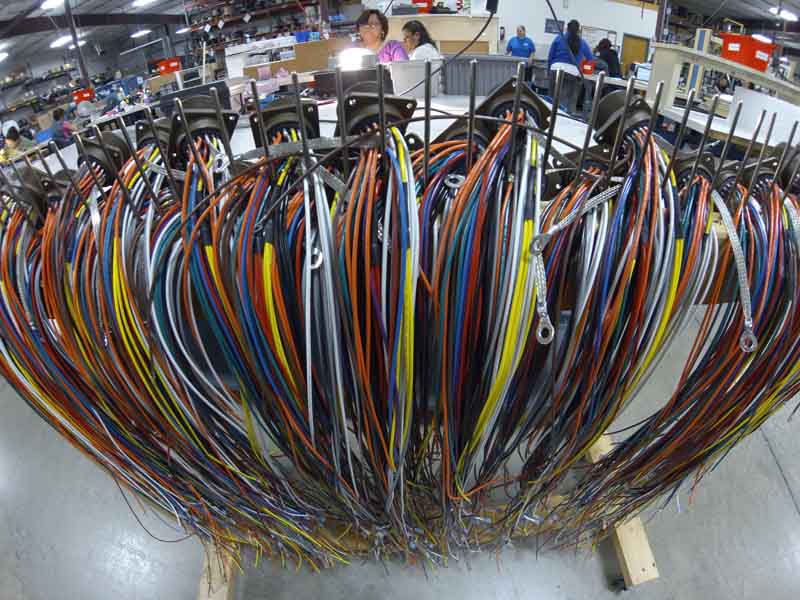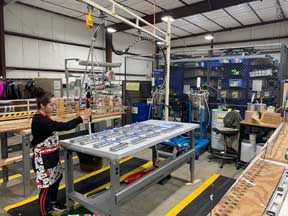Profile: Excel Connection
It’s great to be in the right place at the right time. It’s even more important, however, to know what to do when you get there. Joe Marshall was in that situation in 1986. He listened to some advice, saw an opportunity in front of him, and started Excel Connection (originally MR Custom). I’m usually happy to speak with one or two individuals when I interview for the Profile. This time, I was able to speak with the entire management team, Joe Marshall, owner, Colleen Weber, Business Manager, Shaun McGuire, General Manager, Greg Harpster, Sales Manager, Andrew Hoffmeier, Quality Manager, Elizabeth Nunez, Marketing/Engineering and Steve Osterberg, Sales/Estimating.
Ten years prior to the inception of his wire harness company, Joe had started another company called Marshall Erecting. The company did large scale machine and conveyor installation and moving. He did business with heavy manufacturers in the Midwest like General Electric and Allis-Chalmers. “We were growing, then we hit a downturn with Detroit and all the major manufacturing centers closing down, so I decided I better look for another business,” Joe outlined.
One of his best customers was GE. Joe noticed they were offloading their entire harness manufacturing to Mexico. Like many companies, they were also about to gut their entire harness knowledge base. He always had a great relationship with the staff within the facilities he serviced and found out there might be an opportunity for prototype and small quantity harnesses. “I was approached by someone at GE who said, ‘you’ve got a good reputation and if you can swing it financially, you could get some of these folks making harnesses,’ so I thought it would be a good time to hire them.”
Joe quickly employed two of the folks who had just been laid off, set up an area for them in the Marshall Erecting building in St. Francis, WI, and started building assemblies. “We began making feedthroughs which were simple connectors with wires running through, then sealed with epoxy,” he described. These early products were for GE X-ray equipment, and they needed to be shielded from moisture. The small but savvy team quickly pivoted to other builds using similar feedthroughs technologies, along with other simple harnesses. “We did a lot of first articles and prototypes and eventually got into more companies like GE and Allis-Chalmers,” Joe remembered. These were many of his legacy customers with Marshall Erecting.
Through the years, their expertise grew, as did the breath and complexity of their product offering. As the Marshal Erecting footprint diminished, the Excel Connection side of the business took more and more of the facility. They eventually took over a space across the street, but even that proved too small. “I couldn’t find a place in St, Francis where I could put up a building,” Joe recalled, “so I found this brownfield in Milwaukee that had been vacant for ten years, and I decided to take on that battle in 1998.”
The location was an old paint factory, and Joe had to remove endless truckloads of dirt in efforts to clean up the facility. It took much more time and resources than expected. They continued to dig sample wells that came back with toxic results. “The cleanup was supposed to take five years – it took almost 20 to get full release paperwork. It was supposed to cost $50,000 – it cost $1.2 million,” he lamented. He managed to get some relief with state and federal grants tax credits, but those came with strings. “I had to put up a new building and employ 50 employees, and I only had a certain amount of time to get that done.” But Joe persevered, and Excel moved into the new facility in 2001.

The cleanup of the dilapidated old brownfield, and subsequent new building, was an incredible boost to the local landscape. “We’re actually located in a pretty nice neighborhood with houses right across the street and some other light industry on our side,” Colleen described. That commitment to the environment has transcended throughout Excel with a rigorous recycling program. “We recycle all of our wood pallets, plastic reels, and cardboard and are involved in a lot of community cleanup efforts.” The company has even found a home for the larger wooden reels at a lion nature preserve.
Shawn jumped into the conversation discussing the business when he entered in 2003. “I came onboard, and we were about a $2.4 million company doing a lot of lead wires and small assemblies. At the request of our customers, we got into larger assemblies that required 100% continuity testing.” They began routinely processing four-gauge and two-gauge wire by 2005, but by 2008 they had requests for up to 500 MCM wire. Around this time frame, the company was also investing heavily in automation.
By 2012, they were fortunate to get business from a mining equipment company that ceased in-house harness production, but that took some doing. “They weren’t sure they wanted us because we were a small company,” Shawn explained. “But Joe called a meeting with the decision makers and firmly asked, ‘If you thought we were too small, why did you ask us to quote the business?’” His frank nature and firm assurances won the day. They got the business and soon received four semi loads of raw materials from the company to go through to support their harness needs. “And that’s where we were able to use the Marshall Erecting expertise,” Joe advised. “Those spools weigh thousands of pounds, and we were able to build the frames and rigging to handle the spools and pull the heavy wire through conduits.”

Things progressed nicely, and by 2015, they had added automation and were building harnesses up to 50 feet long with 220 wires. But they began to be plagued by workflow issues. That’s when Colleen came in and implemented a new MRP/ERP system. It was the single biggest investment the company has made in the past 15 or so years, and it has paid off massively. “Our late orders went from 20% to 5%, and our overall efficiency went from 64% to 95%, so it’s been a huge savings and has helped grow the company,” Colleen mentioned. They were also able to reduce their temporary workforce, all through attrition. “Our old system was antiquated, and it took hours to get reports, and now they’re available at our fingertips in real time,” she said. “We’ve got monitors all over the shop that tell people what jobs to work on, and they’re interactive so they can communicate with each other in different areas to get jobs done on time and in the right priority.”
This increased efficiency allowed the company to further differentiate itself from its competitors. They offered a Vendor Managed Inventory (VMI) program that helped them grow even more. “We actually go into our customers facilities once or twice a week and restock their bins so they can continue to operate seamlessly.” Colleen detailed. “They really like it because they don’t have to hold on to components or worry about stocking harnesses or lead wires; they just have to worry about getting their finished product out the door,” Shawn added.
Today, Excel is using about 30,000 sq ft of manufacturing space, with about 76 employees. The current footprint includes an additional space they currently rent out to another company. “I have one more unit to use up, but we’re good for about another 3 1/2 years right here,” Joe assured. But he has other property should they need to expand beyond that.
Excel is ISO 9001 certified and builds to the WHMA/IPC A-620 specification. “We really strive in quality,” stressed Colleen. “We constantly monitor our internal processes and make improvements to make sure quality is brought to the forefront.”
I asked the crew what made them an unmistakable supplier to their customers. They all cited unparalleled quality and response time, but Shawn zeroed in on their knowledge of their customers specific products and processes. “I’m not joking when I say we know what they need before they do,” he proclaimed. “We’ll call them and say, ‘hey, we know you’re working overtime, tell us what lines so we can be prepared.’ Or we’ll see orders coming in for certain products and say, ‘well, those are medium voltage, so won’t you be needing some of these harnesses too?’”
It’s not just the scheduling and purchasing folks they work well with. They also work closely with their customers’ engineering staff. “About 60-70% of the drawings come in with some kind of issue we have to correct before we can build it.” Shawn said. “Sometimes they’ll have a wire that is too large for the terminal, or they’ll specify tin plated terminals, but we know from experience that they need gold terminals for that application.” The team also does a lot of reverse engineering where a customer will provide a rough prototype and Excel will create a drawing and produce a first article harness.

So, what’s in the future for Excel? Shawn indicated they are looking at different markets that would fit their capability. “We’ve been brainstorming, and we brought on a new salesperson who is really good at bringing on specialty automotive opportunities,” he noted. Joe chimed in to mention his son, Paul, has recently been named the company’s CEO. “His goal is to get the company to grow quite a bit, and financially we are able to do that within the space we have available and the years of experienced staff working in this industry.”
































































